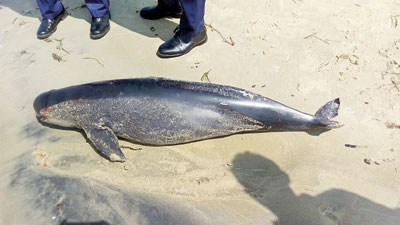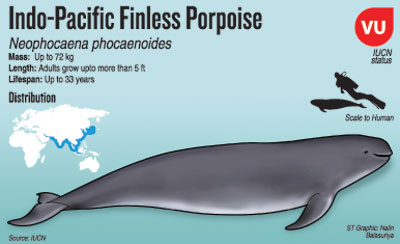News
Porpoise completes Lanka’s full hand of cetacean wonders
Sri Lankan waters are home to 30 species of marine mammals, including dugongs, whales and dolphins. Now the remaining member of the cetacean group, the porpoise, officially joins this list.

Indo-Pacific finless porpoise washed ashore at Talaimannar (c) Department of Wildlife Conservation
The porpoise is a close relative of the dolphins; both look similar, with a shorter beak helping to distinguish the porpoise.
There are six species of porpoises in the world and researchers confirmed the kind found here is the Indo-Pacific finless porpoise (Neophocaena phocaenofides).
In a paper recently published in the Journal of Threatened Taxa, researcher Ranil Nanayakkara writes that he first observed pods of Indo-Pacific finless porpoises during survey trips in 2014. In addition, a photograph by Sandaruwan Abeyratne showing a marine mammal washed ashore off Talaimannar beach, was identified as being of the same species.
The researchers continued obtaining records of dead specimens of Indo-Pacific finless porpoises, confirming their presence in our waters. The paper quotes local fishermen describing a marine mammal found near the islands of Adam’s Bridge as having features that match those of the porpoise.
“Their presence in the Gulf of Mannar and Palk Bay is not surprising as habitats such as shallow estuaries and bays are ideal for these porpoise,” Mr. Nanayakkara said, adding that they were also present off the Indian coast, just 30km away.
The lack of previous scientific records of the porpoise in Sri Lanka could have been due to the war that prevented researchers investigating in these areas, Mr. Nanayakkara added.
This is the only porpoise to lack a true dorsal fin. Instead, there is a low ridge covered in thick skin bearing several lines of tiny tubercles, according to literature. With 15-21 teeth in each jaw, the mammals also have, on average, fewer teeth than other porpoises. The flattened, spade-shaped teeth of porpoises distinguish them from the conical teeth of dolphins. Porpoises are not as acrobatic as dolphins but are quite active swimmers.
The Indo-Pacific finless porpoise is categorised as “vulnerable” to extinction in the International Union for the Conservation of Nature (IUCN) Red List of Threatened Fauna and Flora which states that since this species remains in coastal waters there is a high degree of interaction with humans that often puts it at risk.
They are particularly vulnerable in Sri Lankan waters because they inhabit the heavily-used part of the Palk Bay where boat traffic and fishing pressures are high.
Many porpoises die after becoming entangled in nets. Illegal fishing pressure such as dynamiting and “Leila nets” that enable bottom purse-sein fishing also occur in these areas, posing a threat to the species, the researchers state.
The proposed Sethusamdram shipping canal project aimed at dredging the sea deeper could also pose a bigger threat to the species, Mr. Nanayakkara said.
The fact that this porpoise and other endangered species of marine mammals are regularly encountered off the southern coast of India indicates that a cross-boundary research initiative by Indian and Sri Lankan scientists focusing on the conservation of the species is essential, the researcher pointed out.
“We believe that through such an initiative a more holistic approach could be adopted when studying and conserving the species, which could then be expanded to encapsulate many other marine species and ecosystems,” Mr. Nanayakkara said.
| Bizarre legged fish in lutara catch | |
The ocean still hides many secrets and some bizarre-looking creatures such as the strange fish with legs and a large mouth caught two weeks ago in a Kalutara fisherman’s net about 8km offshore.  Frogfish found off Kalutara. Pic by Sugath Senadeera Residents of Kalutara alerted the Department of Wildlife Conservation about the strange creature and the department sent marine biologists photographs of it to obtain identification. Expert Ranil Nanayakkara identified it as the frog fish. Frogfish, which distantly resemble a typical fish, are about 2.5–38cm long and live at the bottom of the ocean. They are ambush predators that lay motionless on the seabed until the prey comes closer. They move slowly but strike extremely rapidly, sometimes in as little as six milliseconds, without giving chance of scape to unwary Frogfish have a stocky appearance and belong to the Antennarius genus that consists of 11 species. From the photograohs he had been sent, Mr. Nanayakkara tentatively identified the fish caught in Kalutara as the Indian frogfish, Antennarius indicus. Mr. Nanayakkara said he had seen frogfish in Kalpitiya, Hikkaduwa and Trincomalee. |

